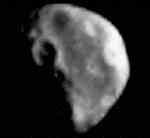243 Ida is a Koronis asteroid orbiting the Sun between Mars and Jupiter:
orbit: 428,000,000 km from the Sun (average)
size: 58x23 km
Ida was a nymph who raised the infant Zeus (Jupiter). Ida is also the name of a mountain on the island of Crete, the site of a classic shrine and the cave where Zeus was said to have been reared.
The second of the small number asteroids that have so far been observed close-up, Ida was encountered Aug. 28, 1993, by the Galileo spacecraft on its way to Jupiter.

Ida has a satellite! (It’s the small spot to the right in the picture above.) It is the first natural satellite of an asteroid ever discovered. Provisionally designated “1993 (243) 1”, it received the name Dactyl (and the permanent designation “(243) Ida I”) in September 1994. The name is derived from the Dactyli, a group of mythological beings who lived on Mt. Ida and protected the infant Zeus. Other accounts are that the Dactyli are the children of the nymph Ida and Zeus.
Dactyl (right) is about 1.6 x 1.2 km, surprisingly round for such a small body. It orbits Ida at approximately 90 km.
The discovery that one out of two asteroids observed up close is in fact a binary system has reinvigorated an old debate about the frequency of binary asteroids. But more data is needed before the controversy can really be resolved.
The application of Kepler’s third law to Dactyl’s orbit gives a rough estimate of Ida’s mass and therefore its density. That value is somewhere between 2.2 and 2.9 grams/cm3 (or perhaps a bit higher), a loose range because Dactyl’s orbit is only crudely known.
Ida was originally thought to be an S-type asteroid, like Gaspra, composed of nickel-iron and some silicates. But a density of 2.9 is too low for that. Instead, Ida could well have a composition like that of ordinary chondrite meteorites, which are primitive and largely unaltered.

Interestingly, while the spectra of Ida and Dactyl are very similar they are nevertheless distinctly different; Dactyl is not simply a chunk of Ida. It is thought that the binary system may have formed during the collision and breakup that created the Koronis family.
The surfaces of Ida and Dactyl are heavily cratered and therefore apparently quite old. But dynamical calculations indicate that the whole Koronis family is relatively young. Such calculations also indicate that objects the size of Dactyl may not be to survive for more than 100 million years or so. Perhaps the heavy cratering took place at the time of the breakup that created the Koronis family rather than the 4 billion years ago as is usually the case for such surfaces.
Galileo measured variations in the solar magnetic field as it passed by Ida (a similar effect was found at Gaspra). This indicates the Ida must contain some magnetic material, though its density is far too low for it to be similar in composition to an iron or stony-iron meteorite.
It seems that many other asteroids are also accompanied by tiny moons. 3671 Dionysus also apparently has a moon as does 45 Eugenia and 762 Pulcova as well as many smaller near-Earth asteroids.
More about Ida and Dactyl
- more images
- from NSSDC
- Ida Nomenclature Table
Open Issues
- What is Ida’s chemical composition?
- How old are Ida and Dactyl?
- Galileo didn’t get very good measurements of Dactyl’s orbit; how can we improve them?
